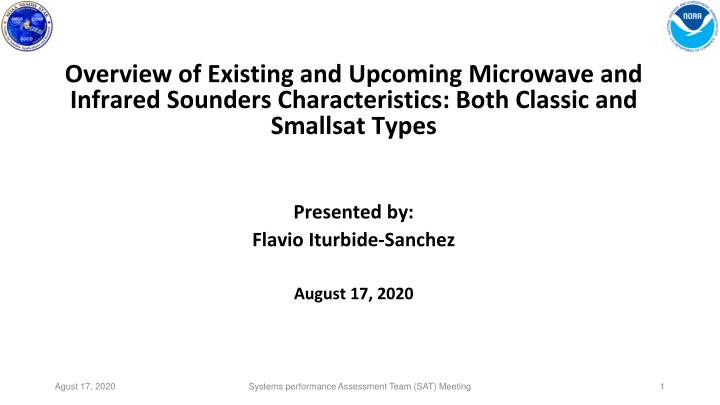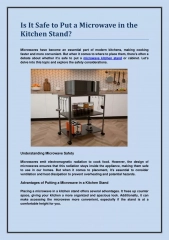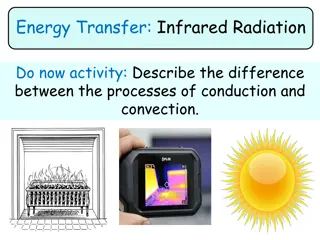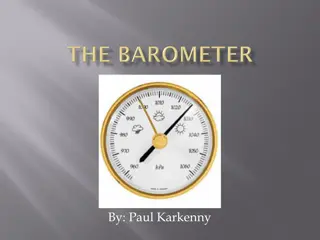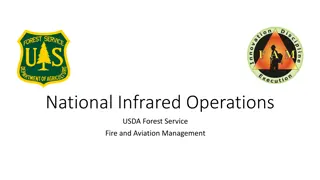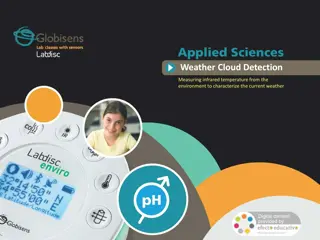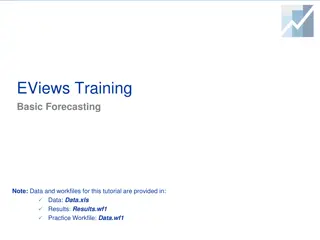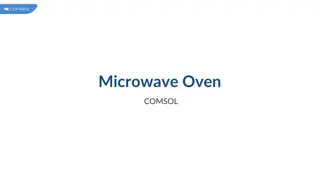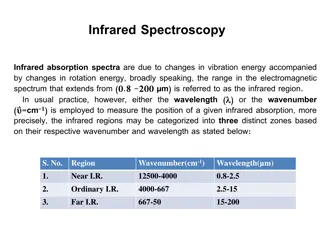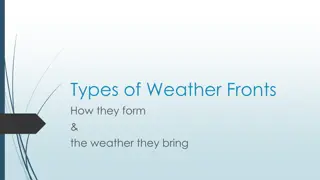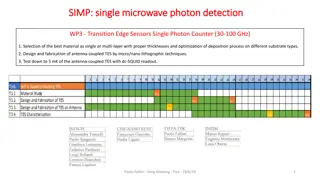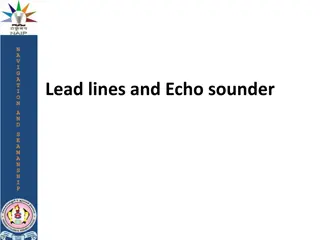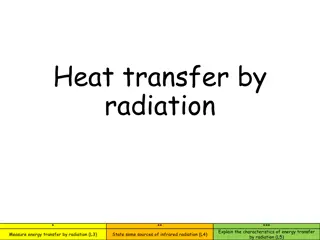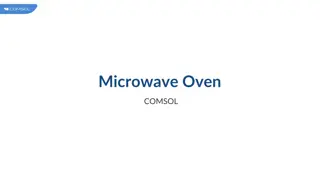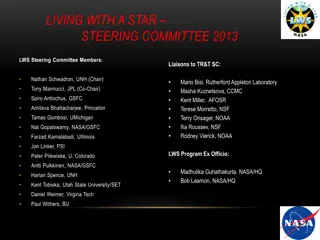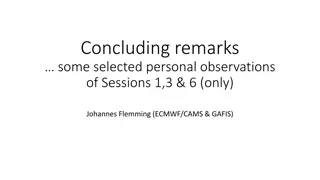Advancements in Microwave and Infrared Sounders for Weather Forecasting
Microwave and Infrared sounders play a crucial role in weather forecasting by providing valuable data for atmospheric studies and climate research. The existing generation of sounders like ATMS, CrIS, and AIRS has been successful, but new advancements in smallsat technology aim to enhance temporal resolution and reduce costs. These new instruments promise similar capabilities to traditional sounders but with lower power consumption, mass, and volume, facilitating the deployment of satellite constellations for improved weather monitoring.
Download Presentation

Please find below an Image/Link to download the presentation.
The content on the website is provided AS IS for your information and personal use only. It may not be sold, licensed, or shared on other websites without obtaining consent from the author.If you encounter any issues during the download, it is possible that the publisher has removed the file from their server.
You are allowed to download the files provided on this website for personal or commercial use, subject to the condition that they are used lawfully. All files are the property of their respective owners.
The content on the website is provided AS IS for your information and personal use only. It may not be sold, licensed, or shared on other websites without obtaining consent from the author.
E N D
Presentation Transcript
Overview of Existing and Upcoming Microwave and Infrared Sounders Characteristics: Both Classic and Smallsat Types Presented by: Flavio Iturbide-Sanchez August 17, 2020 Agust 17, 2020 Systems performance Assessment Team (SAT) Meeting 1
Benefits of Microwave and Infrared Sounders in LEO Orbit IR and MW Sounders provide critical information for weather forecast prediction at National Weather Prediction (NWP) centers worldwide. Observations from IR and MW sounder are valuable for several applications, including Atmospheric Composition and Climate Process Studies IR sounders are capable of providing 3D structures of atmospheric temperature and water vapor with high vertical resolution. Frequent observations from IR sounders at high spatial resolution are expected to contribute to the production of 3D Atmospheric Motion Vector (AMV) winds (critical for improving weather forecast). Microwave sounders have the capability to provide all-weather 3D structures of atmospheric temperature and water vapor. Frequent observations from MW sounders at high spatial resolution are expected to contribute to the better understanding of cloud evolution and precipitation process as well as to improve the tracking and intensity of tropical cyclones. Agust 17, 2020 Systems performance Assessment Team (SAT) Meeting 2
Present Generation of Microwave and Infrared Sounders in LEO Orbit ADVANCED TECHNOLOGY MICROWAVE SOUNDER (ATMS) CROSS-TRACK INFRARED SOUNDER (CrIS) ATMOSPHERIC INFRARED SOUNDER (AIRS) https://www.jpss.noaa.gov/ Credits: L3Harris Technologies https://airs.jpl.nasa.gov/ These sounders are highly successful and capable instruments that has provided good value per year benefit. These instruments were developed with technology from the 90s. Typical power consumption, mass and volume is about 200 W, 200 kg and 1 (1x1x1) m3. Agust 17, 2020 Systems performance Assessment Team (SAT) Meeting 3
New Generation of Microwave and Infrared Sounders in LEO Orbit TEMPORAL EXPERIMENT FOR STORMS AND TROPICAL SYSTEMS - DEMONSTRATION (TEMPEST-D) 6U CubeSat (30x20x10 cm) TIME-RESOLVED OBSERVATIONS OF PRECIPITATION STRUCTURE AND STORM INTENSITY WITH A CONSTELLATION OF SMALLSATS (TROPICS) 3U CubeSat (30x10x10 cm) CUBESAT INFRARED ATMOSPHERIC SOUNDER (CIRAS). 6U CubeSat (30x20x10 cm) https://www.jpl.nasa.gov/cubesat/missions/tempest- d.php https://directory.eoportal.org/web/eoportal/satellite- missions/content/-/article/tropics https://directory.eoportal.org/web/eoportal/satellite- missions/c-missions/ciras New instrumentation is being developed based present mature and advanced technology that has been demonstrated in last decades. Good opportunity to take advantage of these technology. These instruments aim at demonstrating similar capabilities to present operational instrumentation at low cost, enabling the deployment of constellation of IR and MW sounders (higher temporal resolution). Agust 17, 2020 Power consumption, mass and volume is less than 30 W, 15 kg and 0.027 (0.3x0.3x0.3) m3 Systems performance Assessment Team (SAT) Meeting 4
Key Parameters of LEO Hyperspectral IR Sounders Characteristic Sensors AIRS [1-3] CRIS [4] IASI [5] CIRAS [7] CubeSat 6U 30x20x10 cm N/A 450-600 13.5 2000 - Grating Satellite Platform EOS Aqua S-NPP/NOAA-20 MetOp-A/B/C Launch Year(s) Orbital Altitude (km) Nadir Resolution (km) Scan Swath (km) Scan Cycle (s) Spectroscopic Method 2002 705 13.5 1650 2.67 Grating 2011/2017 824 14 2200 8 Interferometer LWIR (650-1095) MWIR (1210-1750) SWIR (2155-2550) 2211 2008/2012/2018 817 12 2052 8 Interferometer LWIR (640.2-1210) MWIR (1210-2100) SWIR (2100-2700) 8461 Spatial LWIR (649-1136) MWIR (1212-1612) SWIR (2169-2673) 2378 Spectral Bands (cm-1) MWIR (1950-2450) Spectral Number of Channels 625 Spectral Resolution (cm-1) 0.55-2.0 0.625 0.5 1.2-2.0 Radiometric NEdT@Temperature (K) 0.07-0.5@250 0.06-0.5@270 0.2-0.6@280 <0.5@250 Data Rate (Mbps) Mass (kg) Average Power (W) 1.3 177 256 2.5 175 245 1.5 236 210 0.5/1.2 12 25 Resources Temperature/Water Vapor/Trace Gases Temperature/Water Vapor/Trace Gases Temperature/Water Vapor/Trace Gases Temperature/Water Vapor Geophysical L2+ Products Agust 17, 2020 Systems performance Assessment Team (SAT) Meeting 5
Key Parameters of LEO MW Sounders Characteristic Sensors ATMS [8] TEMPEST-D [9,10] TROPICS [11] CubeSat 6U 30x20x10 cm 2018 400 14-28 905 2 5 89-183 0.2-0.7 10.3 3.8 6.5 CubeSat 3U 30x10x10 cm 2021 550 25-40 2025 2 12 91.5-205 0.55-1 16 3.8 9.1 Satellite Platform S-NPP/NOAA-20 Launch Year(s) Orbital Altitude (km) Nadir Resolution (km) Scan Swath (km) Scan Cycle (s) Number of Channels Frequency Range (GHz) NEdT (K) Data Rate (kbps) Mass (kg) Average Power (W) 2011/2017 824 16-75 2200 2.67 22 23.8-183.3 0.7-3.6 20 85 130 Temperature/Water Vapor/Precipitation/Cloud Content/Surface Temperature Spatial Spectral Radiometric Resources Water Temperature/Water Vapor/Precipitation/Cloud Content/ L2+ Products Vapor/Precipitation/Cloud Content Geophysical Agust 17, 2020 Systems performance Assessment Team (SAT) Meeting 6
References Main references: [1] M. Chahine, AIRS: improving weather forecasting and providing new data on greenhouse gases, Bull. Amer. Meteor. Soc. 87, 911-926 (2006) [2] Jet Propulsion Laboratory: https://airs.jpl.nasa.gov/mission/instrument/specs/ [3] W. P. Menzel, et al., Satellite-based atmospheric infrared sounder development and applications, Bull. Amer. Meteor. Soc., 99, 583-603 (2018) [4] V. Zavyalov, Noise performance of the CrIS instrument, , J. Geophys. Res.: Atmos., 118, 13108-13120 (2013) [5] F. Hilton, et al., Hyperspectral Earth observation from IASI: five years of accomplishments, Bull. Amer. Meteor. Soc., 93, 347-370 (2012) [6] C. Crevoisier, et al., Towards IASI-New Generation (IASI-NG): impact of improved spectral resolution and radiometric noise on the retrieval of thermodynamic, chemistry and climate variables, Atmos. Meas. Tech., 7, 4367-4385 (2014) [7] T. Pagano, et al., The CubeSat Infrared Atmospheric Sounder (CIRAS) Technology Demonstration in Support of a Future Earth Observing Nanosatellite-Infrared (EON-IR) Atmospheric Sounde, 2018 AMS Annual Meeting (2018) [8] NOAA/NESDIS/STAR, https://www.star.nesdis.noaa.gov/jpss/ATMS.php [9] S. C. Reising, et al., Temporal Experiment for Storms and Tropical Systems Technology Demonstration (TEMPEST-D) mission: early results and potential science capabilities, 2018 AGU Fall Meeting, Washington D.C. (2018) [10] TEMPEST-D fact sheet, https://tempest.colostate.edu/TEMPEST-Fact-Sheet.pdf [11] W. J. Blackwell, et al., An overview of the TROPICS NASA Earth Venture Mission, Quarterly Journal of the Royal Meteorological Society (2018) Agust 17, 2020 Systems performance Assessment Team (SAT) Meeting 7
